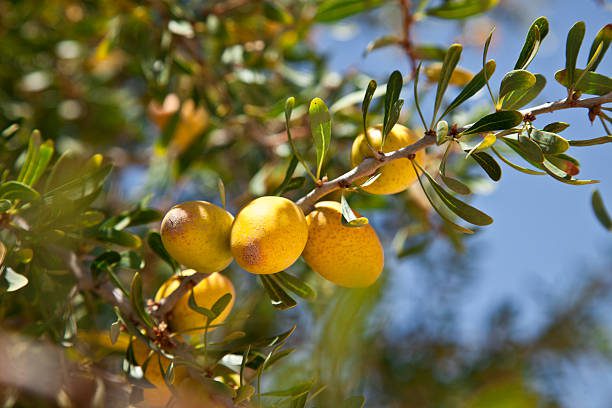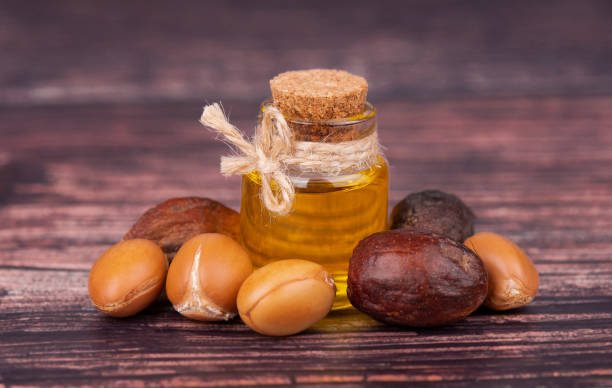Argan oil industry in Morocco
Nestled in the sun-drenched landscapes of southwestern Morocco lies a natural wonder that has captivated the world: the argan tree. These sturdy and resilient ones have sustained local folks for civilizations of humankind, but it is only within decades that people have started appreciating the liquid gold that they yield. The Argan oil industry in Morocco has emerged as a powerful source of economic growth and has become an influencing factor in the changes in people’s lives as well as geographical territories.
Out of the twisted branches of these towering trees comes an ingredient that has hopefully graced kitchens and purses worldwide. Therefore, the story of Argan oil is not only the story of beauty, delicious nuts, and culinary delight; it is a very rich and captivating story of cultural survival and integrated/economic development for women, Bel’Hadj-Smali (2005). Now let’s look deeper into Morocco’s Argan oil business and try to peel the onion of this sector.

The Heart of Argan Country
The Argan oil industry in Morocco is more or less located in the south-western part of the country, with a focus on the areas of Essaouira, Agadir, and Taroudant. This area is the Arganeraie Biosphere Reserve, being the only place on earth that has a natural abundance of argan trees. This species has been found naturally only in this region because of the climatic and soil characteristics that prevail in this region.
Argan forests to the extent that it feels like one is actually going back in time. The trees have contorted trunks and large crowns. With regard to the life span, the trees are known to live for about 200 years. They have evolved best to endure conditions of this part of the world, including extreme dryness, thus playing a role as a checkpoint to the expansion of deserts. This product is thanks to this extraordinary tree and to folk wisdom that has been handed down for centuries.
From Tree to Bottle: The Production Process
The process of obtaining Argan oil from its source to packaging is time-consuming and has not undergone drastic transformation for many years. It is these Berber women who have for generations been the preservers of this ancient art at the core of the Argan oil industry in Morocco.
It starts with the harvesting stage. Fresh fruits of argan are gathered by picking them from the ground or shaking the trees. The exterior is stripped to provide a coarsely coated shell that is then cracked to release the oily seeds in the center. This cracking process is manual, one by one, for each woman, with the expertise of using a stone to crack them without hurting the nuts inside.
Thereafter, the kernels are subjected to a light toasting process (for the culinary-purpose oil) or are left untoasted (for the cosmetic-purpose oil). After roasting, the kernels are then crushed to a thick paste using a milling stone. Those pastes are mixed manually with the occasional addition of water to help emulsify the oil. The final product is obtained by pressing the mixture and getting the natural Argan oil.
This original approach is still being used in many cooperatives across the Argan oil industry in Morocco. But now, some of the bigger players have incorporated mechanical methods in order to enhance the processes’ efficiency and, therefore, yield. Regardless of the method employed, it is vital that the oil produced is of the highest quality, and there are measures in place to ensure this oil is pure and strong.
The Economic Value Of Television Advertising: Liquid Gold
The development of the Argan oil industry in Morocco has been a revolution in the region’s development. A simple product, once utilized for cooking and medicine, has now gone worldwide and thus opened new markets for development in regions that have had high levels of poverty and low resource productivity.
The civilizing process has been evidenced to have had perhaps its greatest influence in the area of women’s liberation. The Argan oil industry in Morocco has given work and wages to thousands of women, most of whom were in a parlous state before the Argan oil industry in Morocco as far as money is concerned. Several cooperatives have since developed throughout the region and have been absorbing the workforce needs besides providing education, healthcare, and societal needs of the communities.
These cooperatives are, in fact, the spine of the Argan oil industry in Morocco. They maintain the employment rates and conditions of their members, together with maintaining the orthodox modes of production. Some also plow back their earnings into community development projects, thus creating a multiplier effect on the people.
The impacts go far beyond the first tier of the company participants, or ‘primary demanders’. This kind of crop has given birth to production and service providers, which include the tourism, packaging, and distribution industries, among others. It has been estimated that the sector currently plays an important role in the country’s gross domestic product and operates export trade to several markets around Europe, North America, and Asia.
Challenges and Sustainability
However, the Argan oil industry in Morocco has its share of problems. This is short, even though very successful. A constant demand in global markets has led to a strain on the scarcity of the argan trees. Goats feed on the fruit, and this leads to overgrazing that hinders regeneration by having detrimental effects on young saplings. Growing concern about climate change also acts as a threat to the trees, as drastic changes in rain patterns may affect growth and fruiting of the trees.
Being aware of these factors, different actors in the Argan oil industry in Morocco have introduced sustainability activities. Conservation efforts are intended to increase the size of the argan forest, while capacity-building initiatives focus on training sustainable collectors. To avoid animals from climbing goats, some cooperatives have implemented mitigation measures to prevent young trees from destruction.
There is also an increase in the concern of freshness and organic, as well as fair trade logos within the Argan oil industry in Morocco. Besides, such certifications help create better production quality and are not always connected with higher producer’s price, which stimulates sustainable production.
The Future of Argan
Looking forward, the Argan oil industry in Morocco is at crossroads. The main issue is to develop further while keeping traditional experience intact, to advance when it is necessary, and not to disrupt primary concerns and methodologies. Since utilizing the fruit for both food and cosmetics is increasingly popular outside the native range of the argan tree, research on its cultivation elsewhere is ongoing in attempts to reduce pressure on the existing forests.
Diversification can also be seen as a possibility for the particular industry, though this has not emerged in the course of writing the paper. Even so, other products made from argan are gaining popularity far beyond the original argan oil, which is currently dominating the market for cosmetics, as additives and preservatives in food supplements. It could create new opportunities for further development and thus stimulate the growth of the countries’ economies and distribute the economic effects even more.

Conclusion
The dilemma of the Argan oil industry in Morocco is perhaps one of the most inspiring in the modern world. A practice that was once conducted locally has flowered into an export business that has created employment and awareness internationally in a hitherto obscure area. It is the perfect example of how indigenous knowledge, together with the markets of today, can in fact deliver what would generally be considered an infinite resource for development.
FAQs
What is the impact of the production of argan oil on the natural environment?
However, it is important to appreciate that, when practiced under proper and sustainable policy, Argan oil production is harmless to the natural environment. The economical merit of trees leads to the protection of trees and calls for planting more trees. But negative impacts like overgrazing are possible; that is why many people in the sphere are already thinking about the conservation.
How do I make sure I am purchasing the correct, higher-standard Argan oil?
Specific Moroccan Argan oil trademarks may include organic, fair trade, or others that would be of importance. It is also good to buy from cooperatives or brands that give information about their sourcing and production. Real Argan oil must indicate it comes from Morocco, and it has a nutty aroma.

